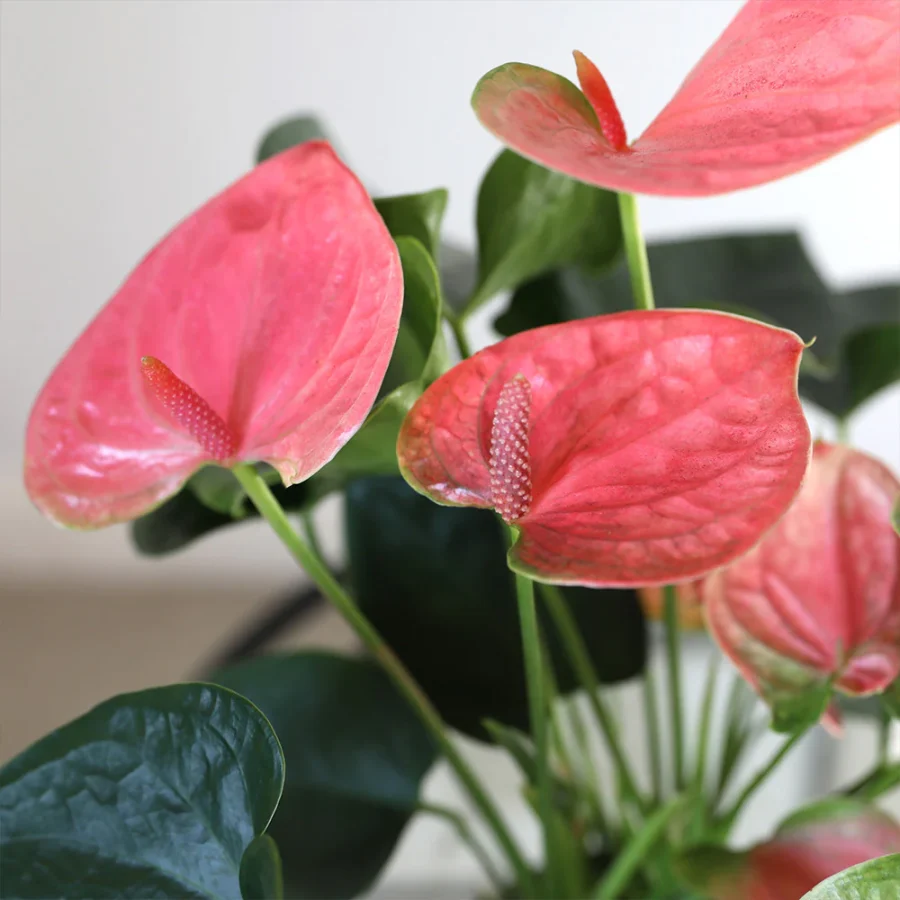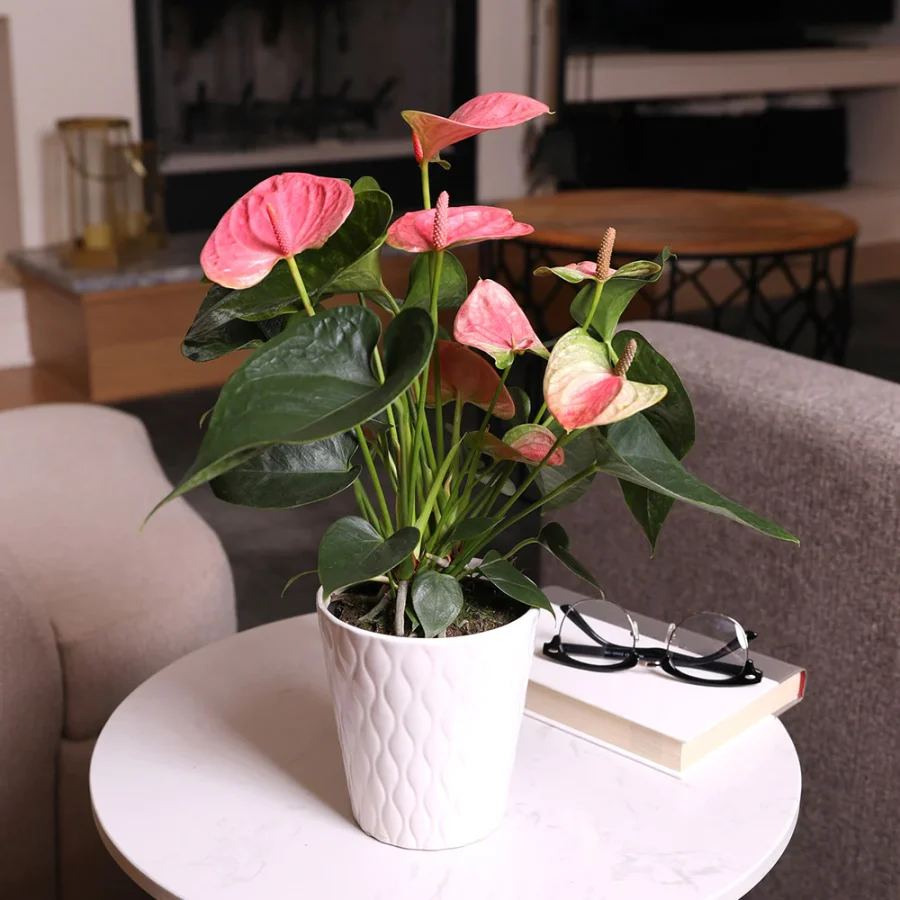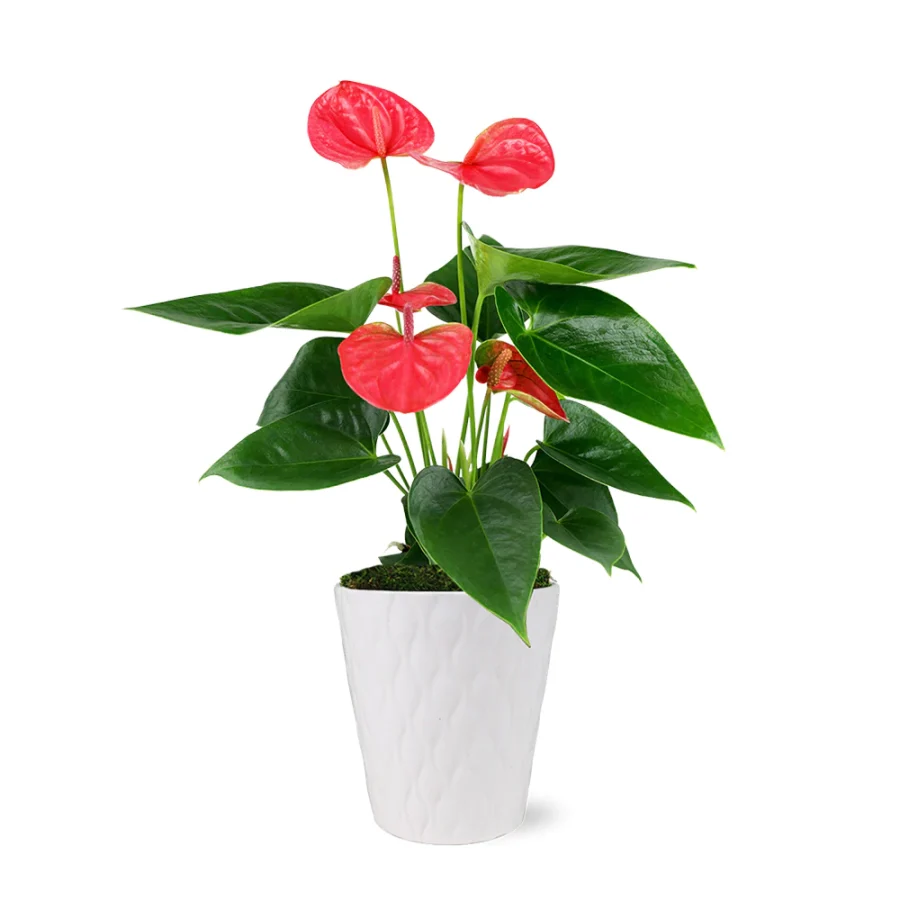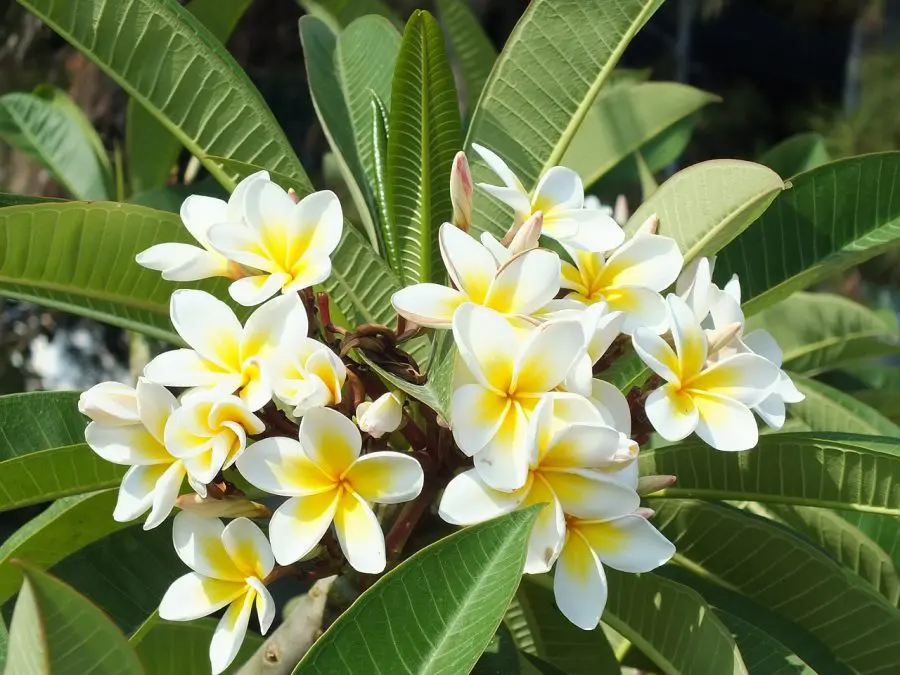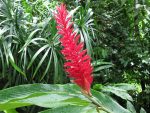This post contains affiliate links. If you buy something from one of our links we may earn a commission. Thanks

Discover the joy of Laceleaf plant care with our easy-to-follow care guide! Uncover tips for thriving plants and explore vibrant cultivars for your indoor garden.
To care for a Laceleaf plant or Flamingo Flower, place it in a location with bright, indirect light. Water the plant when the top inch of soil feels dry, and use a high-humidity environment. Fertilize every 6-8 weeks with a balanced liquid fertilizer. Keep away from direct sunlight and drafts for optimal growth.
Welcome to the wonderful world of laceleaf plant care! Whether you know them as Violet Anthurium, Tail Flower, Flamingo Flower, or Flamingo Laceleaf, these stunning indoor plants are sure to bring a burst of color and tropical charm to your indoor garden.
In this guide, we’ll dive into everything you need to know to keep your laceleaf plants healthy, happy, looking their best, and producing their beautiful anthurium flowers.
So, let’s get started on our vibrant botanical journey together!
An Introduction To Laceleaf Plant Care And Growing Flamingo Laceleaf
Welcome, fellow garden enthusiasts, to our comprehensive guide on growing Flamingo Laceleaf plants!
This gorgeous botanical gem, also known as Violet Anthurium, Tail flower, or Flamingo Flower, can truly enhance the beauty of your indoor or outdoor space.
In this post, we’ll cover everything from the plant’s origins and description to its cultivation, propagation, and the variety of cultivars available.
So, grab your gardening gloves, and let’s embark on this exciting Flamingo Laceleaf adventure together!
The Pink Flamingo Flower – Striking Color and Charm
Boasting a unique blend of the calla lily and peace lily’s features, the Pink Anthurium is an exquisite tropical plant that can be easily grown indoors. Both the glossy modified leaves and its notable spadix – the long, bumpy protrusions that make up the actual flowers – are a vivid pink, which has earned the plant its “Flamingo Flower” moniker.
Anthuriums are known for their impressive blooming duration, being the longest-blooming houseplants available.
They continuously bloom, which means they can display their flowers throughout the entire year!
Accompanying the flowers are the shiny, heart-shaped spathes (the glossy, teardrop structures most prominent on the plant), which are slightly larger than the flowers themselves.
This compact plant reaches just over two feet when fully grown.
With a preference for humidity and bright, indirect light, the Pink Anthurium is an excellent choice for bathrooms or other damp spaces in your home.
However, these adaptable plants can also thrive on windowsills, tables, or other tricky spots as long as they receive adequate light and moisture from the air.
Some gardening enthusiasts even snip Anthuriums for beautiful bouquets!
What’s even better? The Pink Anthurium makes an ideal gift plant, as it arrives in a stylish white container and is topped with moss. It’s ready to brighten up any area of the home right away.
Meet the Laceleaf Plant (Anthurium)
Let’s start by introducing you to the Laceleaf plant, a member of the Anthurium genus.
With around 1,000 species, this genus from South America is known for its stunning, colorful spathes and unique, heart-shaped leaves.
These plants add a touch of tropical elegance to any indoor or outdoor space, making them a beloved choice among garden enthusiasts.
You can buy your flamingo flower here
The Key to Happy Laceleaf Plants: Proper Laceleaf Plant Care
Taking care of your Laceleaf plants is essential to ensure they thrive and showcase their full beauty. Like any other plant, they have specific requirements for light, temperature, water, and nutrients.
By understanding and meeting these needs, you’ll be rewarded with vibrant, healthy plants that brighten up your space and put a smile on your face.
A Plant of Many Names: Embracing the Diversity
You might have heard Laceleaf plants referred to by several different names, such as Violet Anthurium, Tailflower, Flamingo Flower, Laceleaf, or Flamingo Laceleaf.
Each of these monikers captures an aspect of the plant’s charm, be it the stunning violet hue or the graceful, tail-like inflorescence.
No matter what you choose to call them, these plants are sure to capture your heart and imagination with their captivating beauty.
Origin and Description of Laceleaf Plants
Now that we’ve covered the basics, let’s dive deeper into the enchanting world of Laceleaf plants!
In this section, we’ll explore the origins and fascinating features of these captivating botanical wonders.
From their native habitats in the Americas to their intriguing biology and unique characteristics, we’ll help you better understand and appreciate the charm of Laceleaf plants.
So, let’s journey together and uncover the story behind these amazing, vibrant additions to your indoor or outdoor garden!
Exploring the Roots: Laceleaf’s Native Distribution
Laceleaf plants have a fascinating origin story, as they hail from the diverse and vibrant regions of the Americas.
Their native range stretches from northern Mexico all the way down to northern Argentina, with some species even found in parts of the Caribbean.
This widespread distribution has allowed Laceleaf plants to adapt and thrive in various environments, making them a truly versatile addition to your garden.
Unraveling The Flamingo Laceleaf Plant Biology
Dual Growth Habits: Epiphytic and Terrestrial
Laceleaf plants boast a unique characteristic: they can grow as epiphytes, meaning they grow on other plants, or as terrestrial plants rooted in the ground.
This adaptability allows them to thrive in different environments, making them even more fascinating.
Diverse Leaf Shapes: Nature’s Artistry
One of the most striking features of Laceleaf plants is the variety of leaf shapes they can display.
From heart-shaped to elliptical, their leaves showcase nature’s creativity and add an extra layer of visual interest to your indoor or outdoor space.
The Beauty of Inflorescence: Spadix and Spathe
Laceleaf plants are known for their stunning inflorescence, which consists of a central spadix surrounded by a colorful spathe.
The spadix contains small, perfect flowers, while the spathe provides a vibrant backdrop that truly makes these plants stand out.
Fruity Rewards: Juicy Berries with Seeds
After flowering, Laceleaf plants produce juicy berries that vary in color and typically contain two seeds. These fruits are a testament to the plant’s successful pollination and serve as a source of propagation for new plants.
Caution: The Poisonous Side of Laceleaf Plants
While Laceleaf plants are undeniably beautiful, it’s important to be aware of their poisonous nature.
They contain calcium oxalate crystals, which can be harmful if ingested and can cause skin irritation and eye irritation.
Always handle these plants with care and keep them away from children and pets to ensure a safe and enjoyable gardening experience.
Growing Laceleaf Plants
You can buy your Flamingo flower here
Ready to embark on your own Laceleaf plant cultivation journey? You’re in the right place!
In this section, we’ll share all the essential tips and tricks you need to know to grow and care for these stunning plants.
Whether you’re planning to grow them indoors or outdoors, we’ve got you covered with expert advice to help your Laceleaf plants flourish.
So, let’s roll up our sleeves and dive into the wonderful world of Laceleaf plant cultivation!
Growing Laceleaf Plants: Indoors or Outdoors
Choosing the Right Species: Indoor and Outdoor Options
When it comes to growing Laceleaf plants, there are species suitable for both indoor and outdoor cultivation.
Outdoors: These plants are in USDA hardiness zones 10-12 so most of us will be growing them indoors.
For example, Anthurium crystallinum (Crystal Anthurium) and Anthurium clarinervium (Velvet Cardboard Anthurium) are perfect indoor options due to their large, velvety leaves and striking silvery-white venation.
Just make sure to research which species will work best for your specific environment.
The Perfect Soil: Moist and Rich in Organic Matter
Laceleaf plants thrive in moist soil that’s rich in organic matter.
Providing them with the right soil conditions ensures proper nutrient absorption and creates an ideal environment for healthy root development.
This is a crucial aspect of Laceleaf plant care you won’t want to overlook.
Finding the Sweet Spot: Temperature and Light Requirements
To keep your Laceleaf plants happy, pay close attention to their temperature and light needs.
Indoors, these tropical plants prefer warm temperatures between 16-22°C (61-72°F) and indirect light conditions compared to other houseplants.
For outdoor plants, choose a shady spot that provides protection from harsh sunlight.
Humidity Levels
The Laceleaf Plant also thrives in a humid environment so adjust humidity levels. They prefer high humidity of 50-80%
If the air in your home is dry you can use a small humidifier or a pebble tray to increase humidity.
Light Requirements
These plants prefer bright indirect sunlight. Too much light can harm them and while they can adapt to low light levels flowering and growth can be reduced.
The trick is finding the sweet spot where they get enough light but not too much. If you have a south-facing window you can hang a sheer curtain to diffuse the sunlight. Otherwise, an east or north window can work well.
Keeping Your Laceleaf Plants Healthy and Vibrant
Leaf Care: Wipe Away Dust and Pests
To maintain the beauty of your Laceleaf plants’ foliage, it’s essential to regularly wipe their leaves with water.
This simple practice removes dust and potential pests, ensuring your plants continue to look their best.
Feeding Your Plants: Fertilization Tips
A well-fed Laceleaf plant is a happy one! To promote growth and maintain vibrant foliage, use a weak fertilizer solution every other week during the growing season.
Cut back on fertilizing during the winter months. This provides your plants with the necessary nutrients without overwhelming them.
Supporting Climbing Laceleafs: A Helping Hand
For vining or climbing Laceleaf species, providing support is crucial. Offer them a totem or trellis to climb, which will help them grow strong, healthy, and display their beauty to the fullest.
The Ideal Soil Mix: Coco Coir and Perlite
Laceleaf plants prefer a well-draining soil mix that retains moisture without becoming waterlogged.
A great option is a blend of coco coir and perlite. Coco coir, made from the fibers of coconut husks, is excellent at retaining water and provides aeration, while perlite, a volcanic glass, adds drainage and prevents soil compaction.
Combining these materials in a 2:1 ratio (coco coir to perlite) creates a well-balanced growing medium for your Laceleaf plants and helps avoid soggy soil.
You can use a potting mix made from peat moss but add extra perlite to provide good drainage.
I prefer coco coir because it is a renewable environmentally friendly alternative to peat-based soil mixes which deplete natural wetlands and bogs.
Picking the Right Pot Size and Repotting Schedule
Choosing the Perfect Pot
When selecting a pot for your Laceleaf plant, make sure it has drainage holes in the bottom of the pot to prevent water buildup.
Start with a pot that’s slightly larger than the root ball, allowing for about 1-2 inches of space around the roots.
This ensures there’s enough room for growth without the plant becoming root bound.
Repotting Your Laceleaf Plant
As your Laceleaf plant grows, you’ll need to repot it to accommodate its expanding root system.
Generally, it’s a good idea to repot your Laceleaf plant every 2-3 years.
Keep an eye on the plant’s growth; if it begins to look overcrowded in its current pot or if roots start growing out of the drainage holes, it’s time for a new home.
When repotting, choose a container that’s one size larger than the current one and gently transfer the plant, taking care not to damage the roots.
Fill in any gaps with fresh soil mix, and water the plant to help it settle into its new space.
Problems, Pests, and Diseases: Prevention and Treatment
Even the most attentive plant caretakers can occasionally encounter challenges when it comes to keeping their beloved Laceleaf plants healthy.
In this section, we’ll address common problems, pests, and diseases that may affect your Anthurium plants, as well as discuss effective prevention and treatment strategies.
Armed with this knowledge, you’ll be better prepared to tackle any issues that arise and ensure your Laceleaf plants continue to thrive. Let’s dive in and learn how to keep those pesky problems at bay!
Recognizing Common Problems in Laceleaf Plants
Yellowing Leaves: One common issue Laceleaf plant owners may face is yellowing leaves. This could be caused by overwatering, poor drainage, or insufficient light.
To address this issue, ensure your plant is receiving adequate light, and adjust your watering schedule if necessary.
It’s also essential to check that the pot has proper drainage to avoid waterlogged soil.
Browning Leaf Tips: Browning leaf tips can indicate underwatering or low humidity.
To combat this issue, ensure your plant receives consistent moisture and consider increasing the humidity around it.
You can do this by placing a tray with water and pebbles beneath the pot or using a humidifier.
Root Rot: Overwatering can lead to root rot, a fungal infection that damages the plant’s roots.
If you suspect root rot, remove the plant from its pot, trim away any affected roots, and repot it in fresh soil.
Be sure to adjust your watering schedule to prevent future occurrences.
Identifying and Dealing with Pests
Aphids: These small, soft-bodied insects can damage your Laceleaf plant by sucking sap from its leaves.
To control aphids, you can wash them off with a strong spray of water or treat the plant with insecticidal soap or neem oil.
Mealybugs: Mealybugs are tiny, white, cotton-like insects that feed on plant sap, causing weakened growth and discolored leaves.
You can remove them using a cotton swab dipped in rubbing alcohol, or apply insecticidal soap or neem oil to control the infestation.
Spider Mites: Spider mites are minuscule pests that can cause leaf discoloration and webbing.
To combat these pests, wash them off with water or apply insecticidal soap or neem oil to the affected areas.
Combatting Diseases and Infections
Bacterial Blight: This disease is characterized by yellow, water-soaked lesions on the leaves, which can spread rapidly.
If you notice signs of bacterial blight, remove the affected leaves and dispose of them properly. Apply a copper-based fungicide to help control the spread of the disease.
Fungal Infections: Fungal infections can cause a variety of symptoms, including leaf spots, wilting, and mold growth.
To prevent and treat fungal infections, ensure proper air circulation, avoid overwatering, and apply a fungicide if necessary.
Root Rot Prevention and Treatment: As mentioned earlier, root rot is a common issue caused by overwatering.
Ensure proper drainage and adjust your watering schedule to prevent root rot.
You need to find a balance between too little water and too much water. Water when the top inch of soil is dry and avoid adding excess water when it’s not needed.
If you do encounter root rot, trim away affected roots and repot the plant in fresh soil.
Essential Prevention and Treatment Tips
Maintaining Proper Care and Optimal Growing Conditions:
The best way to prevent problems is by providing your Laceleaf plant with the appropriate care and growing conditions.
This includes proper light, watering, humidity, and temperature.
Using Natural Remedies and Targeted Treatments:
Many pests and diseases can be treated with natural remedies like neem oil or insecticidal soap.
For more severe issues, targeted treatments such as fungicides or insecticides may be necessary.
Knowing When to Seek Professional Help:
If you’re unable to manage pests or diseases on your own, don’t hesitate to seek the help of a professional horticulturist or local garden center for advice and assistance.
They can provide expert guidance on the best course of action to restore your Laceleaf plant’s health.
Propagating Laceleaf Plants
Are you ready to spread the Laceleaf love? In this section, we’ll dive into the exciting world of Laceleaf plant propagation!
We’ll guide you through the various methods of creating new plants from your existing ones, so you can share the joy of these stunning beauties with friends and family, or simply expand your own collection.
So, let’s get started and uncover the secrets of successful Laceleaf plant propagation together!
Growing A New Life: Seed Propagation
One way to propagate your Laceleaf plants is by growing them from seeds.
When the berries on your plant ripen, you can collect the seeds and sow them in a well-draining, moist soil mix.
Place the pot in a warm, bright location, but avoid direct sunlight. Keep the soil consistently moist, and with a little patience, you’ll soon see seedlings sprouting!
Remember, though, that growing Laceleaf plants from seeds can be a slow process and might not produce plants identical to the parent.
Branching Out: Vegetative Propagation Through Stem Cuttings
Another method for propagating Laceleaf plants is through cuttings.
• To do this, carefully remove healthy stem cuttings with at least two leaves from the parent plant.
• Trim the stem to about 1-2 inches below the lowest leaf and remove any lower leaves, leaving only the top ones.
• Plant the cutting in a moist soil mix, and keep it in a warm, bright spot, away from direct sunlight.
• Maintain consistent moisture and, in a few weeks, the cutting should develop roots and start growing into a new plant.
The Commercial Route: Tissue Culture
In the commercial Anthurium trade, tissue culture is the preferred method for propagating Laceleaf plants.
This technique involves taking small plant tissue samples and placing them in a sterile culture medium, where they’re provided with the necessary nutrients and hormones to grow.
Tissue culture allows for the mass production of genetically identical plants, ensuring consistent quality and appearance.
While this method is mostly used in commercial settings and beyond the scope of most home gardeners, it’s still a fascinating aspect of Laceleaf plant propagation to be aware of.
Breeding and Cultivars
Ready to dive deeper into the captivating world of Laceleaf plants? In this section, we’ll explore the art of breeding and the diverse range of cultivars available.
Laceleaf breeders work tirelessly to develop new, eye-catching varieties with unique shapes and vivid colors, ensuring there’s always something new and exciting to discover.
Join us as we delve into the fascinating realm of Laceleaf breeding and cultivars, where innovation and creativity meet the beauty of nature.
Breeding Goals: Spotlight on the Spadix and Spathe
When it comes to breeding Laceleaf plants, the spadix and spathe are the stars of the show.
These two striking features of the plant are the main focus for breeders, who aim to create new and exciting varieties by enhancing their colors, patterns, and overall appearance.
The result? A stunning array of Laceleaf cultivars that captivate and inspire plant enthusiasts everywhere.
Foundation Species: Anthurium scherzerianum and Anthurium andreanum
Two of the most common species used in Laceleaf breeding are Anthurium scherzerianum and Anthurium andraeanum.
These species are particularly popular among breeders because they naturally produce bright red spathes, making them an ideal starting point for creating a wide variety of vibrant cultivars.
By crossbreeding these species with others, breeders can unlock an array of new possibilities.
Celebrating Diversity: Cultivars with Unique Colors and Shapes
Through meticulous breeding efforts, countless Laceleaf cultivars have been developed, each boasting its own unique combination of colors, shapes, and patterns.
This incredible diversity ensures that there’s a Laceleaf variety to suit every taste and preference.
Whether you’re drawn to bold reds, soft pinks, or even striking patterns, you’re sure to find a Laceleaf cultivar that speaks to your heart and adds a touch of beauty to your home or garden.
Flamingo Flower FAQs
Laceleaf and Flamingo Flower are common names for the Anthurium plant, known for its unique, colorful spathes and lush foliage.
These captivating plants not only brighten up living spaces but are also relatively easy to care for, which makes them a popular choice for indoor gardening.
Whether you’re a seasoned plant enthusiast or a beginner looking to add a touch of tropical flair to your home, you might have some questions about the plant’s identification, care, and other aspects.
Let’s dive into some frequently asked questions to provide you with a deeper understanding.
Q: Which flower is also called laceleaf or flamingo flower?
A: The Anthurium plant is commonly referred to as Laceleaf or Flamingo Flower.
Q: What is the other name for flamingo flower?
A: The other name for Flamingo Flower is Laceleaf. Both names refer to the Anthurium plant.
Q: How do I identify a flamingo plant?
A: A Flamingo plant, or Anthurium, can be identified by its unique, glossy, heart-shaped spathe that comes in various colors like red, pink, or white. The plant also has dark green, oblong leaves and may produce a thin, elongated spadix.
Q: What is the common name for laceleaf?
A: The common name for Laceleaf is Flamingo Flower. Both refer to the Anthurium plant.
Q: How do you take care of an anthurium laceleaf plant?
A: To care for an Anthurium Laceleaf plant, place it in bright, indirect light and keep it in a high-humidity environment. Water when the top inch of soil feels dry and fertilize every 6-8 weeks with a balanced liquid fertilizer.
Q: Is anthurium laceleaf poisonous?
A: Yes, Anthurium Laceleaf is considered poisonous if ingested and can cause irritation upon skin contact. It contains calcium oxalate crystals, which can be harmful to pets and humans.
Whether you’re growing a Laceleaf or Flamingo Flower, understanding its needs and potential hazards will help you take better care of the plant. These beautiful plants can make a stunning addition to your home when their specific care requirements are met.
Laceleaf Plant Care Final Thoughts
As we wrap up our journey through the enchanting world of Laceleaf plant care, we hope you’ve gained valuable insights and tips to help your plants thrive.
From understanding their origins and biology to mastering cultivation and propagation techniques, you’re now well-equipped to nurture and grow these captivating beauties.
Remember, the key to successful plant care lies in the love and attention you provide. So, go ahead and embrace the joy of Laceleaf plants, and watch them flourish under your care. Happy growing!
Revisiting the Essentials: Key Laceleaf Plant Care Tips
As we conclude our Laceleaf plant care adventure, let’s take a moment to recap some of the crucial tips we’ve covered:
• Providing the right soil mix, such as a blend of coco coir and perlite
• Ensuring proper temperature, light conditions, and moisture levels
• Regularly wiping leaves and following a suitable fertilization schedule
• Offering support for vining or climbing Anthuriums
• Exploring various propagation methods to expand your collection
The Path to Success: Proper Care for Thriving Laceleaf Plants
The importance of proper care for your Laceleaf plants cannot be overstated. By following the guidelines we’ve discussed, you’re laying the foundation for healthy, vibrant plants that will reward you with their stunning appearance.
As with all living things, consistent attention and care are key to helping your Laceleaf plants reach their full potential.
Embrace the Rainbow: Exploring Different Laceleaf Cultivars
Lastly, we encourage you to explore the vast world of Laceleaf cultivars and add a touch of variety to your indoor or outdoor garden.
With countless colors, shapes, and patterns available, there’s a Laceleaf plant that perfectly suits your style and preferences.
By experimenting with different cultivars, you can create a visually stunning and diverse collection that will bring joy and inspiration to you and all who encounter it. Happy planting!
Discover The20 Benefits Of Keeping Indoor Plants For Improved Lifestyle

